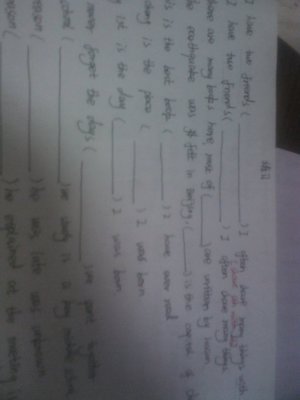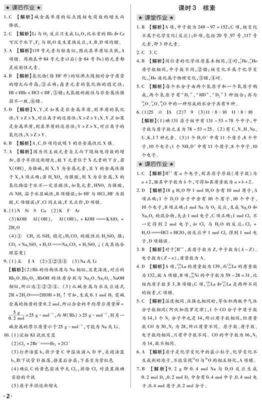关系词
引导定语从句的关联词称为关系词,关系词有关系代词和关系副词。关系代词有that, which, who, whom, whose, as等,绝对没有what;关系副词有where, when, why等。关系词常有3个作用:
①连接作用,引导定语从句。
②代替主句中的先行词,甚至可能是主句中的一部分或者整个主句。
③在定语从句中充当一句子成分。
注:关系代词有主语、宾语之分。一般whom作为宾语。关系代词在从句中作主语,宾语,表语,定语等,关系副词在从句中作地点状语,时间状语,原因状语等。
定语
定语用来限定、修饰名词或代词的,是对名词或代词起修饰、限定作用的词、短语(动词不定式短语、动名词短语和分词短语)或句子,汉语中常用'……的’表示。主要由形容词担任,此外,名词,代词,数词,分词,副词,不定式以及介词短语也可以来担任,也可以由一个句子来担任。单词作定语时通常放在它所修饰的词之前,作前置定语。短语和从句作定语时则放在所修饰的词之后,作后置定语。
先行词
被定语从句修饰的名词、代词称为先行词。
关系代词引导的定语从句举例
关系代词所代替的先行词是人或物的名词或代词,并在从句中充当主语、宾语、定语等成分。关系代词在定语从句中作主语时,从句谓语动词的人称和数要和先行词保持一致。
who, whom, that
这些词代替的先行词是人的名词或代词,who做主语指人,whom作宾语指人,that既可作主语又可作宾语(作宾语可以省略),可以指人也可以指物。在从句中所起作用如下:
(1) Is he the man who/that wants to see you?
他就是想见你的人吗?(who/that在从句中作主语)
(2) He is the man whom/ that I saw yesterday.
他就是我昨天见的那个人。(whom/that在从句中作宾语)
Whose 用来指人或物
(只用作定语, 若指物,它还可以同of which互换,指人的时候也可以用of whom 代替) (1) They rushed over to help the man whose car had broken down.
那人车坏了,大家都跑过去帮忙。
(2) Please pass me the book whose (of which) color is green.
请递给我那本绿皮的书。
which, that
它们所代替的先行词是事物的名词或代词,在从句中可作主语、宾语等,作宾语时可以省略,例如:
(1) A prosperity which / that had never been seen before appears in the countryside. 农村出现了前所未有的繁荣。(which / that在句中作主语)
(2) The package (which / that) you are carrying is about to come unwrapped. 你拿那个包裹快要散开了。(which / that在句中作宾语)
4、 as as 可以做主语,也可以作宾语,作宾语时可以省略,指人或者物。常与such as,the same as等短语连用。
限定性定语从句
关系代词
关系代词:在句中作主语、宾语或定语
1. that既可代表事物也可代表人,which代表事物;它们在从句中作主语或宾语,that在从句中作宾语时常可省略关系词,which在从句中作宾语也可以省略。
[eg:This is the book (which)you want.]
2. 如果which在从句中作“不及物动词+介词”的介词的宾语,注意介词不要丢掉,而且介词总是放在关系代词which的前边,但有的则放在它原来的位置
3. 代表物时多用which,但在下列情况中用that而不用which:
a)先行词是anything, everything, nothing , none等不定代词时;
b)先行词由every, any, all, some, no, little, few, much等修饰时,这时的that常被省略;
c)先行词前有序数词或被形容词最高级修饰时;
d)先行词中既有人又有物时;
e)整个句中前面已有which,who,that时;
f)当先行词为物并作表语时;
g)先行词为one时;
h)先行词同时又被the only,the very,the same修饰时;
4. who和whom引导的从句用来修饰人,分别作从句中的主语和宾语,whom作宾语时,要注意它可以作动词的宾语也可以作介词的宾语
5. whose是关系代词,修饰名词作定语,相当于所修饰成分的前置所有格.它引导的从句可以修饰人和物, 当它引导的从句修饰物体时, 可以与 of which 调换,表达的意思一样。
关系副词
关系副词:在句中作状语 关系副词=介词+关系代词 why=for which where=in/ at/ on/ ... which (介词同先行词搭配) when=during/ on/ in/ ... which (介词同先行词搭配)
1. where是关系副词,用来表示地点的定语从句。
2. when引导定语从句表示时间[注]值得一提的是,表示时间“time"一词的定语从句只用when引导,有时不用任何关系代词,当然也不用that引导。
By the time you arrived in London, we had stayed there for two weeks.
到你到达伦敦的时候,我们在那里已经待了两个星期。
I still remember the first time I met her. 我仍然记得我第一次见到她。
Each time he goes to business trip, he brings a lot of living necessities, such as towels, soap, toothbrush etc。
每一次他去出差,他带来了生活必需品,如毛巾,肥皂,牙刷等,很多。
3. 当从句的逻辑主语是some, any, no, somebody, anybody, nobody, something, anything, everything或nothing时,常用there is来引导 There is somebody here who wants to speak to you. 这里有人要和你说话。
非限制性定语从句非限制性定语从句的作用是对所修饰的成分作进一步说明,通常是引导词和先行词之间用逗号隔开,将从句拿掉后其他部分仍可成立
1. which引导的非限定性定语从句作用是说明前面整个句子的情况或主句的某一部分
2.当先行词是专有名词、物主代词或指示代词所修饰时,其后的定语从句通常是非限制性的,例如:
Charles Smith, who was my former teacher, retired last year.
查理·史密斯去年退休了,他曾经是我的老师。
My house, which I bought last year, has got a lovely garden.
我去年买的的那幢房子带着个漂亮的花园。
This novel, which I have read three times, is very touching.
这本小说很动人,我已经读了三遍。
3.非限定性定语从句可将整个主句作为先行词, 对其进行修饰, 这时从句谓语动词要用第三人称单数,例如:
He seems not to have grasped what I meant, which greatly upsets me.
他似乎没抓住我的意思,这使我心烦。
Liquid water changes to vapor, which is called evaporation. 液态水变为蒸汽,这就叫做蒸发。 4. 有时as也可用作关系代词
5. 在非限定性定语从句中,不能用关系副词why和关系代词that,而用who, whom代表人,用which,whose代表事物,如果需要用why,可用for which代替.;p.s: which引导的非限制性定语从句其后不可省略成分,as可以
关系代词引导的定语从句
who指人在从句中做主语
(1) The boys who are playing football are from Class One. 在踢足球的男孩们是一班的.

(2) Yesterday I helped an old man who lost his way. 昨天,我帮助了一个迷路的老人.
whom指人,定语从句中充当宾语,常省略。
(注:who和whom已无太大区别,基本可以通用。区别是who可以做主语而whom不可以,whom前可以加介词如to whom,但是who不可以)
(1) Mr. Liu is the person (whom) you talked with on the bus.
刘先生就是在公交车上和你聊天的那个人.
(2) Mr. Ling is just the boy(whom)I want to see.
凌先生恰巧就是我想见的那个男孩.
(3) The man who/whom you met just now is my friend.
你刚刚见到的那个人就是我的朋友.
注意:关系代词whom在口语和非正式语体中常用who代替,可省略。
如果在从句中做宾语,就用whom或who.比如:
He is the man whom/who I talk to. 他就是那个和我聊天的男人.
如果是在从句中作主语就只能用who.比如:
He is the man who has an English book. 他就是那个有英语书的男人.
whose通常指人也可指物,在定语从句中做定语。
He has a friend whose father is a doctor.
他有一个朋友的父亲是医生.
(2) I once lived in a house whose roof has fallen in.
whose指物时通常以以下结构来代替
(3) The classroom whose door is broken will soon be repaired.
那个门被打破的教室不久会被修复。
(4) The classroom the door of which is broken will soon be repaired.
课堂门,被打破会不久被修复。
(5) Do you like the book whose color is yellow?
你喜欢颜色是黄色的书吗?
(6) Do you like the book the color of which is yellow?
你喜欢的书的颜色,是黄色吗?
which指物 在定语从句中做主语,表语,定语或者宾语,做宾语时可省略。
(1) Football is a game which is liked by most boys. 足球是大多数男孩都喜欢的游戏.
(2) This is the pen (which) he bought yesterday. 这是他昨天刚买的钢笔.
that指人时,相当于who或者whom;指物时,相当于which。在定语从句中做主语,表语或者宾语,做宾语时可省略。
5) The number of the people that/who come to visit the city each year rises one million.
数目的人民那个/谁来城市观光每年上升之一个百万
(6) Where is the man that/whom I saw this morning?那个男人在哪里/我看见谁了今天早上?
关系副词引导的定语从句
when指时间,在定语从句中做时间状语也可做连接词用
(1) I still remember the day when I first came to the school.
(2) The time when we got together finally came.
where指地点,在定语从句中做地点状语
(1) Shanghai is the city where I was born.
(2) The house where I lived ten years ago has been pulled down.
why指原因,在定语从句中做原因状语
(1) Please tell me the reason why you missed the plane.
(2) I don’t know the reason why he looks unhappy today.
注意:关系副词引导的从句可以由“介词+关系代词”引导的从句替换
(1) The reason why/ for which he refused the invitation is not clear,
(2) From the year when/in which he was going to school he began to know what he wanted when he grew up.
介词和关系代词
1)介词后面的关系代词不能省略。
2)that前不能有介词。
3) 某些在从句中充当时间,地点或原因状语的"介词+关系词"结构可以同关系副词when ,where和why 互换。
This is the house in which I lived two years ago.
This is the house where I lived two years ago.
Do you remember the day on which you joined our club?
Do you remember the day when you joined our club?
This is the reason why he came late.
This is the reason for which he came late.
介词+关系代词引导的定语从句关系代词在定语从句中做介词宾语时
从句常由介词+关系代词引导 当介词放在关系代词前面时,关系代词只能用which/whom即“介词+which/whom"且不能省略。但当介词位于末尾时可用that/which/who/whom.作介词的宾语,且可以省略。例如:
(1) The school (that/which) he once studied in is very famous."that/which"可以省略
= The school in which he once studied is very famous."which”不可省略
(2) Tomorrow I will bring here a magazine (that/which) you asked for.
= Tomorrow I will bring here a magazine for which you asked.
(3) We’ll go to hear the famous singer (whom/that/who) we have often talked about.
= We’ll go to hear the famous singer about whom we have often talked.
注意:
1. 含有介词的动词短语一般不拆开使用,
如:look for, look after, take care of等
T This is the watch which/that I am looking for. (T=正确)
F This is the watch for which I am looking. (F=错误)
2. 若介词放在关系代词前,关系代词指人时用whom,不可用who或者that;指物时用which,不能用that;关系代词是所有格时用whose
(1) The man with whom you talked is my friend. (T)
The man with that you talked is my friend. (F)
(2) The plane in which we flew to Canada is very comfortable. (T)
The plane in that we flew in to Canada is very comfortable. (F)
3. “介词+关系代词”前可有some, any, none, both, all, neither, most, each, few等代词、数词或者名词。
(1) He loved his parents deeply, both of whom are very kind to him.
(2) In the basket there are quite many apples, some of which have gone bad.
(3) There are forty students in our class in all, most of whom are from big cities.
(4)The boat, the name of which is Topsail, is famous.
(5)I bought many books yesterday, three of which are written by Lu Xun.
关系代词
关系代词(一般情况下)that 可用在从句做主语,谓动词的宾语,但是不能做介词的宾语。 which指物,在从句中作主语,谓语或宾语;who在从句中作主语;whom在从句中作宾语;where在从句中修饰表地点的名词,做地点状语;when在从句中通常修饰表时间的名词,做时间状语;why在从句中做原因状语,先行词通常是"reason" 有时why也可用for+which代替。
例:A doctor is a person ‖who looks after people's health.
主语 谓语 先行词 定语从句修饰先行词
判断介词和关系代词
方法一: 用关系代词,还是关系副词完全取决于从句中的谓语动词。不及物动词后面无宾语,就必须要求用关系副词或者是介词加关系代词;而及物动词后接宾语,则要求用关系代词。
例如:
This is the mountain village where I stayed last year.
I'll never forget the days when I worked together with you.
判断改错(注:先显示题,再显示答案,横线;用不同的颜色表示出。)
(错) This is the mountain village where I visited last year.
(错) I will never forget the days when I spent in the countryside.
(对) This is the mountain village (which) I visited last year.
(对) I'll never forget the days (which) I spent in the countryside.
习惯上总把表地点或时间的名词与关系副词 where, when联系在一起。此两题错在关系词的误用上。
方法二: 准确判断先行词在定语从句中的成分(主、谓、宾、定、状),也能正确选择出关系代词/关系副词。
例1. Is this museum ___ you visited a few days ago?
A. where B. that C. on which D. the one
例2. Is this the museum ____ the exhibition was held?
A. where B. that C. on which D. the one
答案:例1 D,例2 A
例1变为肯定句: This museum is ___ you visited a few days ago.
例2变为肯定句: This is the museum ___ the exhibition was held.
在句1中,is后应跟表语,只有the one可以,而后面的you visited a few days ago则做one的定语从句,而句2中, 主、谓、宾俱全,从句部分为句子的状语表地点,既可用副词where,又因 in the museum词组,可用介词in + which 引导地点状语。而此题中,介词on 用的不对,所以选A。
关系词的选择依据在从句中所做的成分,先行词在从句中做主、定、宾语时,选择关系代词 (who, whom, that, which, whose);先行词在从句中做状语时,应选择关系副词 ( where 地点状语,when 时间状语,why 原因状语) 。
先行词和关系词
1)Whoever spits in public will be punished here. (Whoever 可以用 anyone who 代替)
2)The parents will use what they have to send their son to technical school. (what 可以用all that代替) 。
但这两句句子已经不是定语从句了,是名词性从句。因为定语从句一定要有先行词,而名词性从句没有。将“Whoever”、“what”分别用“Anyone who”、“all that”代替后,才是定语从句,先行词分别是“Anyone”、“all”。
as,which引导的非限制性定语从句
由as, which 引导的非限定性定语从句,as和which可代整个主句,相当于and this或and that。As一般放在句首,which在句中。
As we know, smoking is harmful to one's health.
The sun heats the earth, which is very important to us.
典型例题
1)Alice received an invitation from her boss, ___came as a surprise.
A. it B. that C. which D. he
答案C。此为非限定性从句,不能用 that修饰,而用which.,it 和he 都使后句成为句子,两个独立的句子不能单以逗号连接。况且选he句意不通。
2)The weather turned out to be very good, ___ was more than we could expect.
A. what B. which C. that D. it
答案B。 which可代替句子,用于非限定性定语从句,而what不可。That 不能用于非限定性定语从句,it不为连词,使由逗号连接的两个句子并在一起在英语语法上行不通。
3)It rained hard yesterday, ____ prevented me from going to the park..
A. that B. which C. as D. it
答案B。
as 和which在引导非限制性定语从句时,这两个关系代词都指主句所表达的整个意思,且在定语从句中都可以作主语和宾语。但不同之处主要有两点:
(1) as 引导的定语从句可置于句首,而which不可。
(2) as 代表前面的整个主句并在从句中作主语时,从句中的谓语必须是系动词;若为行为动词,则从句中的关系代词只能用which.。在本题中,prevent由于是行为动词,所以正确选项应为B。
As 的用法例
例1. the same… as;such…as 中的as 是一种固定结构, 和……一样……。
I have got into the same trouble as he (has).
例2. as可引导非限制性从句,常带有'正如'。
As we know, smoking is harmful to one's health.
As is known, smoking is harmful to one's health.
As是关系代词。例1中的as作know的宾语;
例2中,它充当从句的主语,谓语动词know要用被动式。
一、“as / which” 特殊定语从句的先行成分
1. 形容词或形容词短语作先行成分, 具有形容词意义的介词短语也可以充当先行成分,如:
My grandmother’s house was always of great importance to me, as my own is.
在一定的语言环境里,有些名词可以具有形容词的性质。这些名词主要是那些表示人的身份、职业、状态的名词。值得一提的是,在这些具有形容词性质的名词之后,引导定语从句的关系代词不能用who / whom.
2. 动词短语先行成分。
这种动词短语既可是限定形式也可是非限定形式。如果是动态动词短语,它们在从句中就一般有限定或非限定形式的替代动词do和as / which一起代替。do可以出现,也可以不出现,但不能用其它动词代替。
3. 句子作先行成分。
这句子可以是整个主句也可以只是主句中的一个从句。有时是连续几个句子,有时甚至可以是一个完整的故事。
二、“as/which”特殊定语从句在句中的位置
由于先行成分的构成成分不同,“as/which”特殊定语从句在句中的位置有以下几种情况:
1. 形容词做先行成分时:
形容词或形容词短语(含具有形容词性质的名词)作先行成分,“as / which”特殊定语从句置于先行成分之后。
2. 动词短语作先行成分时:
动词短语作先行成分时,“as / which”特殊定语从句置于先行成分之后。但是,当从句中含有表示主观意志的插入成分时,“as”特殊定语从句可以移至句子之首。
3. 句子作先行成分时:
“as”特殊定语从句的位置较灵活,可以置于先行成分之前、之中或之后。但如果先行成分是直接引语,“as”特殊定语从句多在先行成分之前。如果先行成分是否定句,“as”特殊定语从句与否定词的相对位置不同可以使它产生不同的意义。由于“as”特殊定语从句具有这一特点,所以有时它的位置不能随便移动。在非正式的文体里,“which”特殊定语从句可以出现在先行成分之中。
三、“as/which”特殊定语从句的语义功能
一般说来,as与which的语义功能相同,可以相互替换。但先行成分为句子时,它们的语义功能则有差异。
1. 表示结果
表示结果的特殊定语从句与其先行成分之间存在着一定的因果关系,从句中往往使用有结果意义的词,如动词result, make, enable, cause和形容词interesting, surprising, delightful, disgraceful等。
2. 表示评注
表示评注的特殊定语从句对其先行成分所述事实的正确性有肯定的倾向,它通常与那些表示客观事实,普遍真理或某种习性的先行成分连用;从句中则常用一些表示“合乎自然规律”、“众所周知”或“经常发生”等意义的词语,如natural, known to all, usual等。 3. 有无状语意义
“as”特殊定语从句具有状语意义(主要是方式状语意义),而“which”特殊定语从句则无状语意义。“as”特殊定语从句的状语意义要求它在语义上与其先行成分的语义保持一致,“which”特殊定语从句则不受这种限制。
四、关系代词as与which的句法功能
1. as / which 在特殊定语从句中作主语。
as作主语时,谓语动词常为连系动词(主要是be, seem),主语补语为usual、 a rule、 a matter of fact等时,系动词be习惯经常省略。行为动词作“as”特殊定语从句的谓语时一般用于被动语态(其中助动词be常略),不及物的行为动词在“as”特殊定语从句中作谓语的极少,常见的有happen一词。如:
Freddie, as might be expected, was attending the conference.
Which作主语时,谓语动词不限,主动被动皆可,只是谓语动词为被动语态时助动词be省略。
2. as和which都可以在特殊定语从句中宾语。
3. as和 which在特殊定语从句中作补语。如:
We thought him a gentleman, as/which he could never be.
“as”特殊定语从句中可以主谓倒装,“which”从句中则不能主谓倒装。
如果先行成分不是主语补语或宾语补语,关系代词用which而不用as。如:
He talked like a native, which/as he hardly was.
4. which在特殊从定语句中作定语。
which可以在特殊定语从句中作定语,修饰fact, matter, thing 等名词。这些名词代表先行成分表达的意义,有时将其略去句义仍然完整。as不能作定语。如:
I was told to go not by train but bus, which advice I followed.
关系代词that 的用法
(1)不用that的情况
(a) 在引导非限定性定语从句时。
(错)The tree, that is four hundred years old, Is very famous here.
(b) 介词后不能用。
We depend on the land from which we get our food.
We depend on the land that/which we get our food from.
只能用that作为定语从句的关系代词的情况
(a) 在there be 句型中,只用that,不用which。
(b) 在不定代词,如:anything, nothing, the one, all等作先行词时,只用that,不用which。
(c) 先行词有the only, the very,the same,the last,just修饰时,只用that。
(d) 先行词为序数词、数词、形容词最高级时,只用that,不能用which。.
(e) 先行词既有人,又有物时。
(f) 先行词指物,在主句中作表语时.
(g) 为了避免重复.
(h)先行词是the way或the reason时,that可作关系副词,也可省略
(i) 主句的主语是疑问词who /which时
举例:
Is this the book that you borrowed in the library?
这是你在图书馆借的那本书吗?
Who that break the window should be punished.
谁打碎了窗户都要受到惩罚.
All that is needed is a supply of oil.
所需的只是供油问题。
Finally, the thief handed everything that he had stolen to the police.
那贼最终把偷的全部东西交给了警察。
that必用
1.先行词是最高级或被最高级修饰
2.是序数词或被序数词修饰
3.不定代词
4.先行词即指人又指物
5.被only;the every,no,one of等修饰
6.主句有which;who;whom
7.there be 句型中
8.如果有两个从句,其中一个关系代词已用了which,另一个关系代词宜用that
9.先行词在主句中作表语,或者关系代词本身作从句的表语是宜用that ,that在作宾语时可省
难点分析
(一)限制性定语从句只能用that的几种情况
1、当先行词是anything, everything, nothing (something 除外), few, all, none, little, some等代词时,或者是由every, any, all, some, no, little, few, much,each等修饰时
(1) Have you taken down everything (that) Mr. Li has said?
(2) There seems to be nothing (that) seems impossible for him in the world.
(3) All that can be done has been done.
(4) There is little (that) I can do for you.
注意1:部分时候that可以省略,如部分例句将that用括号括住。
注意2:当先行词指人时,偶尔也可以用who
(4) Any man that/.who has a sense of duty won’t do such a thing.
2、当先行词被序数词修饰
The first place that they visited in London was the Big Ben.
3、当先行词被形容词最高级修饰时
This is the best film that I have seen.
4、当形容词被the very, the only,the same,the last ,any,little等修饰时
(1) This is the very good dictionary that I want to buy,
(2) After the fire in his house, the old car is the only thing that he owned.
当先行词指人时,偶尔也可以用who
(3) Wang Hua is the only person in our school who will attend the meeting?
5、当先行词前面有who, which等疑问代词时
(1) Who is the man that is standing there?
(2) Which is the T-shirt that fits me most?
6、当先行词既有人,也有动物或者物体时
Can you remember the scientist and his theory that we have learned?
7.当关系代词在定语从句中做表语
The village is no longer the one that it used to be 10 years ago. 8.当在there be句型中,通常情况下用that,不用which
(二)关系代词as和which引导的定语从句as和which引导非限制性定语从句,有相同之处也有不同之处。具体情况是:
1、As和which都可以在定语从句中做主语或者宾语,代表前面整个句子。
(1) He married her, as/which was natural.
(2) He was honest, as/which we can see.
2、as 引导非限制性定语从句,可放在主句之前,或者主句之后,甚至可以切割一个主句;which引导的非限制性定语从句只能放在主句之后。另外,as有“正如……,正像……”的意思
(1) As is known to all, China is a developing country.
(2) He is from the south, as we can see from his accent.
(3) John, as you know, is a famous writer.
(4) He has been to Paris more than several times, which I don’t believe.
注意:当主句和从句存在逻辑上的因果关系时,常用which。
Tom was always late for school, which made his teacher angry.
3、当先行词受such, the same修饰时,常用as
(1) I have never heard such a story as he tells.
(2) He is not such a fool as he looks.
(3) This is the same book as I lost last week.
注意:当先行词由the same修饰时,偶尔也用that引导定语从句,但是和由as所引导的定语从句意思不同
(4) She wore the same dress that she wore at Mary’s wedding. 她穿着她在MARY婚礼上穿过的一条裙子。
(5) She wore the same dress as her young sister wore. 她穿着和她妹妹所穿的一样的裙子。
注意:定语从句such…as …与结果状语从句such… that…的区别:as在所引导的定语从句中作主语,宾语;that在结果状语从句中不做成分
(6)He has such a good laptop as I want to buy.
(7)He has such a good laptop that I want to buy one.
(三)以the way为先行词的定语从句通常由in which, that引导,而且通常可以省略。
The way in which/ that/./ he answered the question was surprising.
(四) but有时也可以做关系词引导定语从句
There are very few but understand his idea。 ( but= who don’t )
(五) 区分定语从句和同位语从句
1、定语从句修饰先行词,它和先行词是修饰关系;同位语从句说明先行词的具体内容,是补充说明的关系
(1) The plane that has just taken off is for London. 定语从句
(2) The fact that he has been dead is clear. 同位语从句
2、定语从句由关系代词或者关系副词引导,关系词在句中充当成分,有时可以省略;同位语从句主要由that引导,在句中一般不做成分;句子也可以由when, where, how, why, whether, what等词引导,充当成分
(1) The news he told me is true.
(2) The news that he has just died is true.
(3) The problem that we are facing now is how we can collect so much money. 定语
(4) The problem how we can collect so much money is difficult to solve.
3、 同位语从句和先行词一般可以用be动词发展成一个完整的句子,而定语从句不可以发展成一个完整的句子,
(1) The idea that we could ask the teacher for advice is wonderful. 同位语
(2) The idea was that we could ask the teacher for advice.
(3) The fact that the moon moves around the earth is known to all.
(4) The fact is that the earth moves around the earth. [
定语从句]介词+关系词
1)介词后面的关系副词不能省略。
2)that前不能有介词。
3)某些在从句中充当时间,地点或原因状语的"介词+关系词"结构可以同关系副词when 和where 互换。
例如:
This is the house in which I lived two years ago. 这是我两年前住过的房子。
This is the house where I lived two years ago.
Do you remember the day on which you joined our club? 还记得你加入我们俱乐部的那一天吗?
Do you remember the day when you joined our club?
 爱华网
爱华网


